Art Periods – A Detailed Look at the Art History Timeline
For as long as we have been able to use our hands, we have been creating unique artworks that document our context and state of mind. From early cave paintings to the ceiling of the Sistine Chapel, human artistic expression can tell us a lot about the lives of the people who created it. To fully appreciate the cultural, social, and historical significance of different artworks, you need to be aware of the art history timeline and the major periods that shaped it. This article presents an overview of the most significant eras of creation and the historical contexts from which they originated.
Art Eras: Tracing the Earliest Art Periods
The earliest artworks have been identified as Paleolithic cave paintings, which date back to roughly 40,000 years ago. There have been many discoveries that document human activity from this period and have taken shape in many spectacular rock shelter paintings and drawings. While it is unclear as to the reasons why early humans began to produce art, it has remained a consistent practice for centuries. Scholars narrow down the purposes of early art as a tool for recording the early cultures, experiences, and local narratives, such that these images and stories were passed onto the next generation.

Despite the many exquisite examples of early artistic expression, the official history of art was recognized by the Romanesque era. Official art era timelines do not include cave paintings, sculptures, and other works of art from the Stone Age or the beautiful frescos produced in Egypt and Crete around 2000 BCE.
The reason behind this is that these early eras of artistic expression were bound to a relatively small geographical space. The official art eras that we will be discussing today span many countries and have mostly originated in Europe and parts of North and South America. Despite their lack of official recognition, these earliest examples of human artistic flair raise a lot of interesting questions. Where did early humans learn to draw so realistically, what inspired early humans to create art, and was art a practice that was taught in prehistoric civilizations?
This article hopes to give you some insight into the ever-changing artistic style of the human creative mind, as we explore the complexities of the different art periods.
Reviewing the Timeline of the Different Art Periods
As with many areas of human history, it is impossible to delineate the different art periods with precision. The dates presented in the brackets below are approximations based on the progression of each movement across several countries. Many of the art periods overlap considerably, with some of the more recent eras occurring at the same time. Some eras last for a few thousand years while others span less than 10 years. Art is a continuous process of exploration, where more recent periods grow out of existing ones.
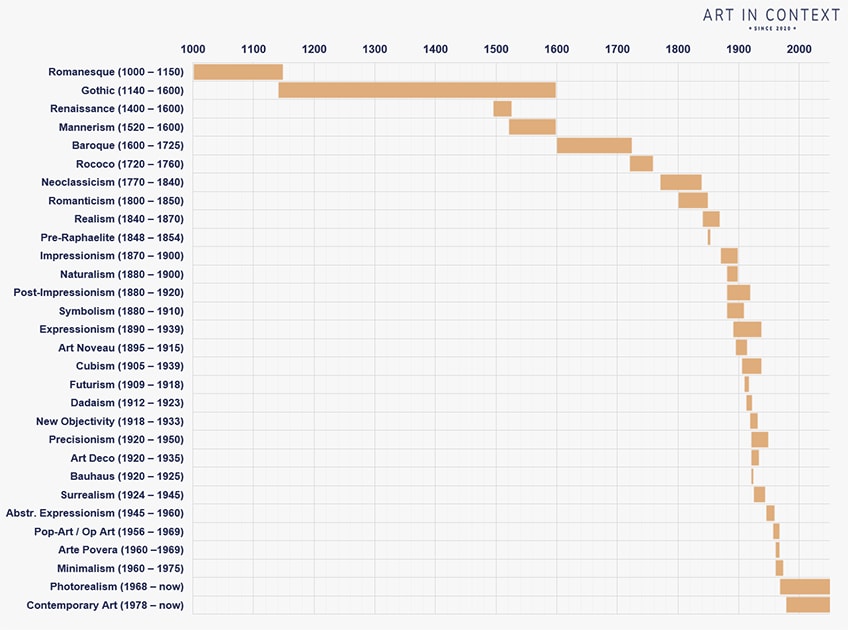
| Art Period | Years |
| Byzantine | 330 – 1453 |
| Romanesque | 1000 – 1150 |
| Gothic | 1140 – 1600 |
| Renaissance | 1495 – 1527 |
| Mannerism | 1520 – 1600 |
| Baroque | 1600 – 1725 |
| Rococo | 1720 – 1760 |
| Neoclassicism | 1770 – 1840 |
| Romanticism | 1800 – 1850 |
| Realism | 1840 – 1870 |
| Pre-Raphaelite | 1848 – 1854 |
| Impressionism | 1870 – 1900 |
| Naturalism | 1880 – 1900 |
| Symbolism | 1886 – 1900 |
| Post-Impressionism | 1886 – 1905 |
| Expressionism | 1890 – 1939 |
| Art Nouveau | 1895 – 1915 |
| Cubism | 1905 – 1939 |
| Futurism | 1909 – 1918 |
| Dadaism | 1912 – 1923 |
| Constructivism | 1913 – 1930 |
| New Objectivity | 1918 – 1933 |
| Harlem Renaissance | 1920 – 1930 |
| Precisionism | 1920 – 1950 |
| Art Deco | 1920 – 1935 |
| Bauhaus | 1920 – 1925 |
| Surrealism | 1924 – 1945 |
| Abstract Expressionism | 1945 – 1960 |
| Pop Art | 1956 – 1969 |
| Arte Povera | 1960 – 1969 |
| Minimalism | 1960 – 1975 |
| Op Art | 1965 – 1970 |
| Photorealism | 1968 – Present |
| Lowbrow Pop Surrealism | 1970 – Present |
| Contemporary art | 1978 – Present |
Art from ancient Greece, including its many temples, ruins, and archaeological sites have provided us with insight into the Classical styles that shaped the Western canon of art for centuries. It may seem strange for our account of the art period timeline to end 30 years ago. The concept of an art era seems inadequate to capture the variety of artistic styles that have grown since the turn of the 21st century.
There is a feeling among some art historians that the traditional concept of painting has died in our era of fast-track living and digital expanse, however, it would be unwise to think that traditional mediums do not have a place in the 21st century. We continue to share our unique human experiences through the medium of art, just as the cave people did outside of our modern system of classification.

A Comprehensive Art Movement Timeline
It is time to dive a little deeper into the social, cultural, and historical contexts of each of the distinct art eras we presented above. You will see how many eras take influence from those before them. Art, like human consciousness, is continuously evolving. It is also important to note that this art timeline is a history of Western and predominantly European art.
The Byzantine Era (330 – 1453): Eastern Roman Empire and Christianization
Byzantine art was a period of increased religious art production that was inspired by the Christianization of Greek culture and the prevailing art styles of the Roman Empire. The Byzantine art period commenced around 330 CE and lasted until 1453. Influential themes on this period included scenes from Greek Hellenistic mythology and Christian literature. Byzantine art is usually categorized into three distinct periods: the Early Byzantine, Middle Byzantine, and Late Byzantine eras.
The styles found in Byzantine painting were religious and devotional, and included angular contours, flat colors, and a distinct gold backdrop. Byzantine styles of the Roman Empire infiltrated architecture and other art forms such as mosaic making, interior decor, and religious buildings as reminders to society of the Christian faith, which promoted “the path to salvation”. Centers such as Constantinople were the hub of artistic expression since it was the center of the Byzantine Empire and the Catholic Church.
The Romanesque Period (1000 – 1300): Sharing Information Through Art
Art historians typically consider the Romanesque art era to be the start of the art history timeline. Romanesque art developed during the rise of Christianity around 1000 CE. During this time, only a small percentage of the European population were literate. The ministers of the Christian church were typically part of this minority, and to spread the message of the bible, they needed an alternative method.
After the fall of the Western Roman Empire in 476 CE, art shifted from the ideals of Classical Greek and Roman art styles to focus on religious art promoted by Christianity. Christian objects, stories, deities, saints, and ceremonies were the exclusive subject of most Romanesque paintings and were intended on educating the masses about the values and beliefs of the Christian Church.
Romanesque art was simple and included bold contours with clean blocks of color. There were also several different forms that artists adopted in Romanesque painting, including wall frescoes, mosaics, panel paintings, and book paintings.
Due to the Christian purpose behind Romanesque paintings, they are almost always symbolic. The relative importance of the figures within the paintings is shown by the size, with the more important figures appearing much larger. You can see that human faces are often distorted, and the stories depicted in these paintings tend to have a high emotional value.
Romanesque paintings often include mythological creatures like dragons and angels, and almost always appear in churches. At the most fundamental level, paintings of the Romanesque period serve the purpose of spreading the word of the bible and Christianity. The name of this art era stems from round arches used in Roman architecture, often found in churches of the time.
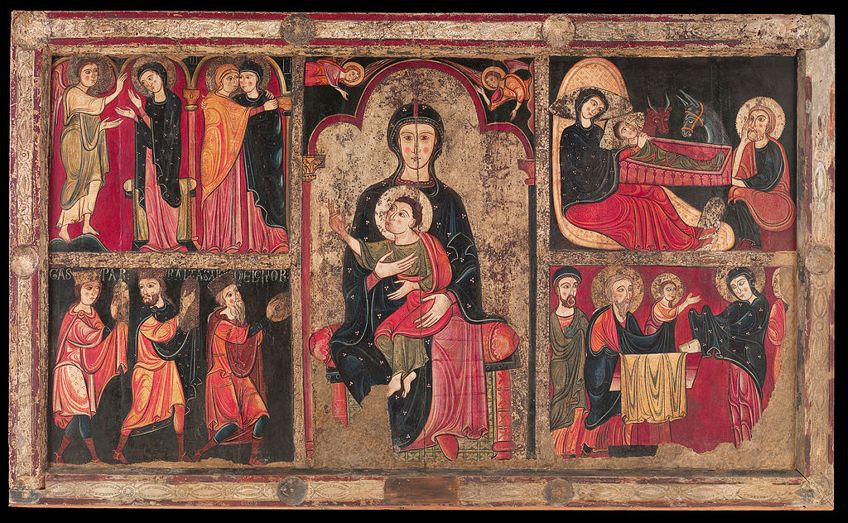
The Gothic Era (1100 – 1500): Freedom and Fear Unite
One of the most famous eras, Gothic art grew out of the Romanesque period in France and is an expression of two contrasting feelings of the age. On the one hand, people were experiencing and celebrating a new level of freedom of thought and religious understanding. On the other, there was a fear that the world was coming to an end. You can clearly see the expression of these two contrasting tensions within the art of the Gothic period.
Just as in the Romanesque period, Christianity lay at the heart of the tensions of the Gothic era. As more freedom of thought emerged, and many pushed against conformity, the subjects of paintings became more diverse. The stronghold of the church began to dissipate.
Gothic paintings portrayed scenes from real life such as laborers in the field and hunting scenes. The focus moved away from divine beings and mystical creatures and tended towards the essence of what it meant to be human.
Human figures received a lot more attention during the Gothic period. Gothic artists fleshed out more realistic human faces, as they became more individual and less two-dimensional. The development of a three-dimensional perspective is thought to have facilitated this change. Painters also paid more attention to subjects of personal value such as clothing, which was typically portrayed realistically.
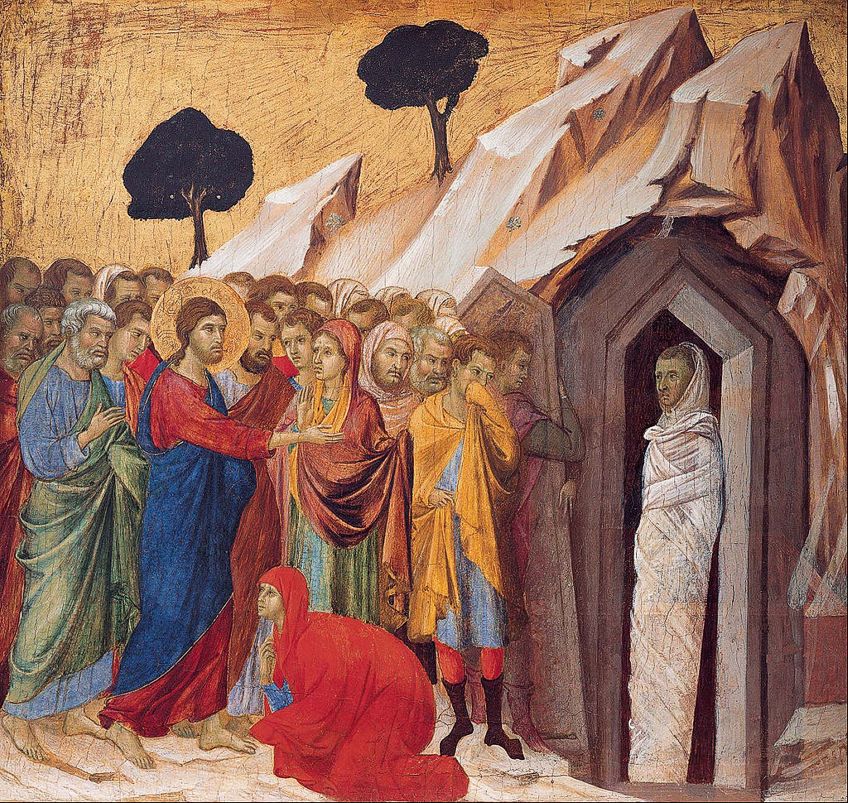
Many historians believe that part of the reason why the subjects of art became more diverse during the Gothic era was due to the increased surface area for painting within churches. Gothic churches were more expansive than those of the Romanesque period, which was thought to represent the increased feelings of freedom at this time.
Alongside the newfound freedom of artistic expression, there was a deep fear that the end of the world was fast-approaching. This was accompanied by a gradual decline in faith in the church, which spurred the expansion of art outside of the church. In fact, towards the end of the Gothic era, works by Hieronymus von Bosch, Breughel, and others were unsuitable for placement within a church.
We do not know many individual artists who painted in the Romanesque period, as art was not about who painted it but rather the message it carried. Thus, the move away from the church can also be seen in the enormous increase in known artists from the Gothic period, including Giotto di Bondone. Schools of art began to emerge throughout France, Italy, Germany, the Netherlands, and other parts of Europe.
The Renaissance Era (1420 – 1520): The Revival of Humanism
The Renaissance era is possibly one of the most well-known, featuring artists like Michelangelo and Leonardo da Vinci. This era continued to focus on the individual human as its inspiration and took influence from the art and philosophy of the ancient Romans and Greeks. The Renaissance can be seen as a cultural rebirth and is usually understood as consisting of several art movements across Europe.
Sandro Botticelli was among the most popular early Renaissance painters, who was later rediscovered by the artists of the pre-Raphaelite movement. Early Renaissance styles of sculpture were further developed by artists such as Donatello, who was inspired by Classical sculpture and was considered to be one of the greatest sculptors in Florence.
A part of this cultural rebirth was the returned focus on the natural and realistic world in which humans lived. The three-dimensional perspective became even more important to the art of the Renaissance, as is aptly demonstrated by Michelangelo’s statue of David. This statue harkened back to the works of the ancient Greeks as it was consciously created to be seen from all angles. Statues of the last two eras had been two-dimensional, intended to be viewed only from the front.

The same three-dimensional perspective carried over into the paintings of the Renaissance era. Frescoes that were invented 3000 years prior were revived by Renaissance painters. Compositions became more complex and the representation of humans became much more nuanced. Renaissance artists painted human bodies and faces in three dimensions with a strong emphasis on Realism.
The paint used during the Renaissance period also represented a shift from tempera paint to oil paint. The Renaissance period is often credited as the very start of great Dutch landscape paintings. Among the leading painters of the Italian High Renaissance was Raphael, who alongside Michelangelo and Leonardo da Vinci, encompassed the essence of ideal Renaissance styles and values.
Mannerism (1520 – 1600): A Window into the Future of Kitsch
Of course, this heading is partly in jest. Not all of the art produced in this era is what we would understand today as “kitsch”. What we understand kitsch to mean today is often artificial, cheaply made, and without much ‘classic’ taste. Instead, the reason we describe the art of this period as being kitsch is due to the relative over-exaggeration that characterized it. Stemming from the newfound freedom of human expression in the Renaissance period, artists began to explore their own unique and individual artistic style, or manner.
Michelangelo was not free from the exaggeration that distinguishes the era of Mannerism. Some art historians do not consider some of his later paintings to be Renaissance-styled works. The expression of feelings, human gestures, and items of clothing were intentionally exaggerated in mannerist paintings.
The S-shaped curve of the human body that characterizes the Renaissance style was transformed into an unnatural contortion of the body. This was the first European style that attracted artists from across Europe to its birthplace in Italy.
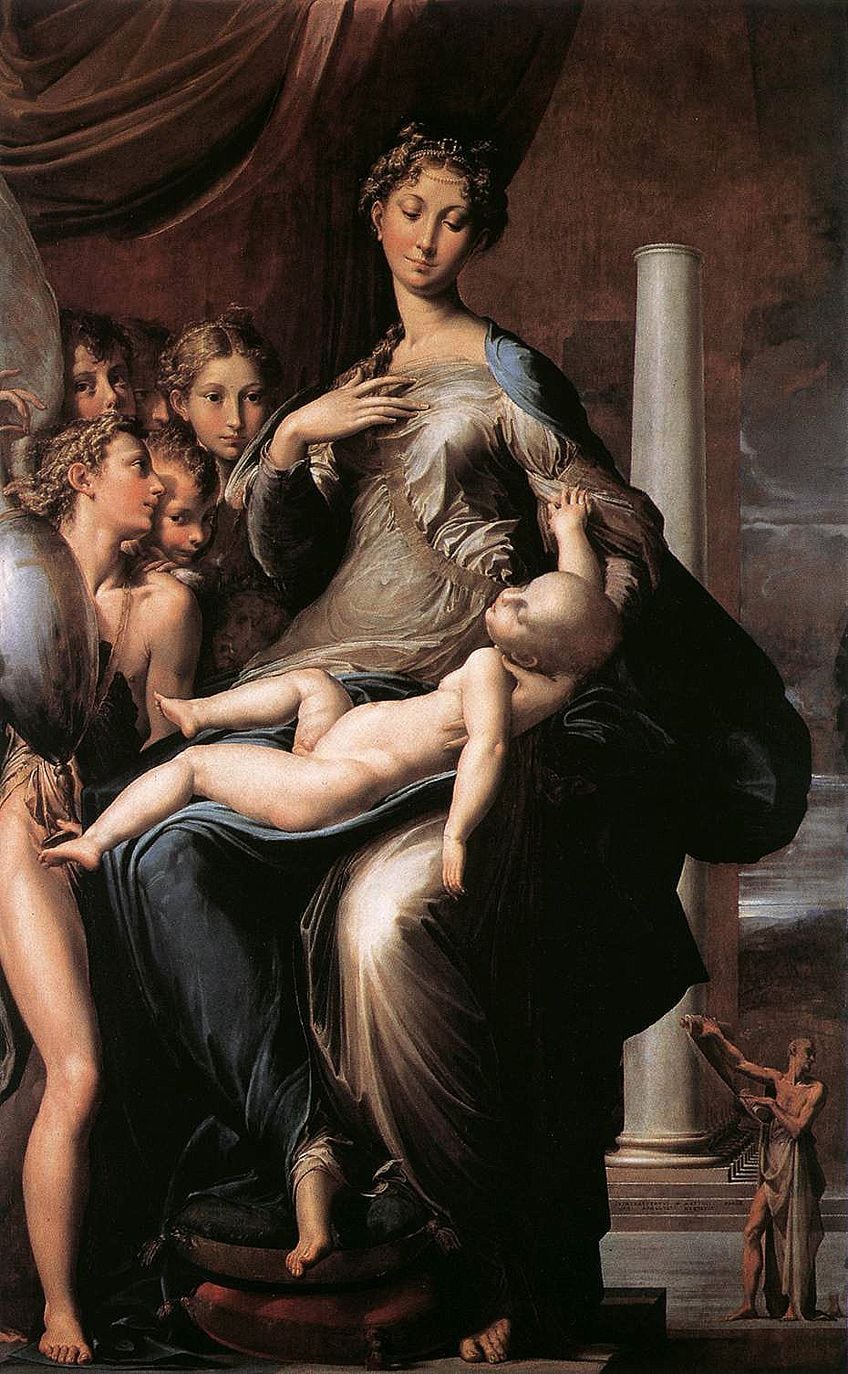
The Baroque Era (1590 – 1760): The Glorification of Power and the Deception of the Eye
The progression of art celebrating the lives of humans over the power of the divine continued into the Baroque era. Kings, princes, and even popes began to prefer to see their own power and prestige celebrated through art than that of God. The over-exaggeration that classified Mannerism also continued into the Baroque period, with the scenes of paintings becoming increasingly unrealistic and magnificent.
Baroque paintings depicted scenes with monarchs ascending into the heavens, mingling with angels, and reaching closer to the divinity and power of God. Here, we really can see the progression of human self-importance, and although the subject matter does not move away entirely from religious symbolism, man was increasingly the central power within Baroque compositions.
New materials that glorify wealth and status like gold and marble become the prized materials for sculptures. Opposites of light and dark, warm and cold colors, and symbols of good and evil are emphasized beyond what is naturally occurring. Art academies increased in their numbers, as art became a way to display your wealth, power, and status.

Prominent artists of the Baroque period included figures like Caravaggio who was considered to be the master of light and chiaroscuro painting. Caravaggio amplified the concepts of divinity and human grandeur through his striking use of contrast in portraiture and religious painting. Another prolific master of Baroque portraiture was Rembrandt, whose theatrical self-portraits continue to inspire many painters who admire the traditions of Baroque art.
The Rococo Art Period (1725 – 1780): French Aristocracy
The paintings from the Rococo era are typical of the French aristocracy of the time. The name stems from the French word rocaille which means “shellwork”. The solid forms which characterized the Baroque period softened into light, air, and desire. Paintings of this era were no longer strong and powerful, but light and playful.
The colors were lighter and brighter, almost transparent in some instances. Many pieces of art from this period neglected religious themes, although some artists like Tiepolo did create frescos in many churches.
Much like the attitude of the French aristocracy of the time, the art of the Rococo period was totally removed from social reality. The shepherd’s idyll became the leading theme of this period, representing life as light and carefree, without the constraints of economic or social hardship.
Classicism (1770 – 1840): A Throwback to Classicism
Classicism, like the Rococo era, began in France in around 1770. In contrast to the Rococo era, however, Classism reverted to earlier, more serious styles of artistic expression. Much like the Renaissance period, Classisim took inspiration from classic Roman and Greek art.
The art created in the Classicism era reverted to strict forms, two-dimensional colors, and human figures. The tone of these paintings was undoubtedly strict. Colors lost their symbolism. The art produced in this era was used internationally to instill feelings of patriotism in the people of each nation. Parts of Classicism include Louis-Sieze, Empire, and Biedermeier.

Romanticism (1790 – 1850): Adding More Feeling to Art
You can see from the dates that this art era occurred at around the same time as Classicism. Romanticism is often seen as an emotionally charged reaction to the stern nature of Classicism. In contrast to the strict and realistic nature of the Classicism era, the paintings of the Romantic era were much more sentimental.
The exploration of emotions and the subconscious took center-stage in Romanticism. Many artists engaged with the natural environment and often took hikes to discover the ways that the natural world influenced their emotions.
There is no tangible or precisely determinable style to the art of the Romanticism period. English and French painters tended to focus on the effects of shadows and lights, while the art produced by German painters tended to have more gravity of thought to them. The Romantic painters were often criticized and even mocked for their interpretation of the world around them.
Realism (1850 – 1925): Objectivity over Subjectivity
As the Romanticism era was a reactionary movement to the Classicism period before it, so is Realism a reaction to Romanticism. In contrast to the beautiful and deeply emotional content of Romantic paintings, Realist artists presented both the good and beautiful, the ugly and evil. The reality of the world is presented in an unembellished way by Realism painters.
These artists attempt to show the world, people, nature, and animals, as they truly appeared. In Realism, there was a focus on the “obligation of art into truth”, as phrased by Gustave Courbet.
Just as with Romanticism, Realism was not popular with everyone. The paintings are not particularly pleasing to the eye and some critics have commented that despite the artist’s claims of Realism, erotic scenes somehow miss the real eroticism. Goethe criticizes Realism, saying that art should be ideal, not realistic. Schiller also calls Realism “mean”, indicating the harshness that many of the paintings portrayed.

Impressionism (1850 – 1895): Heralding the Era of Modern Art
Historians often paint the Impressionist movement as the beginning of the modern age. Impressionist art is said to have closed the book on Classical art and was one of the most easily recognizable art periods of the 20th century. Featuring artists like Claude Monet and Vincent van Gogh, Impressionism broke away from the smooth brush strokes and areas of solid color that characterized many art periods before it.
Initially, the word Impressionism was like a swear word in the art world, with critics believing that these artists did not paint with technique, but rather simply smeared paint onto a canvas. The brushstrokes indeed were a significant departure from those that came before them, sometimes becoming furiously expressive. Distinct shapes and lines disappeared into a whirlwind of colors. Individual dots of completely new colors were put together, particularly in the Pointillism variety of Impressionist paintings. The subjects of Impressionist paintings could often only be recognized from a distance.
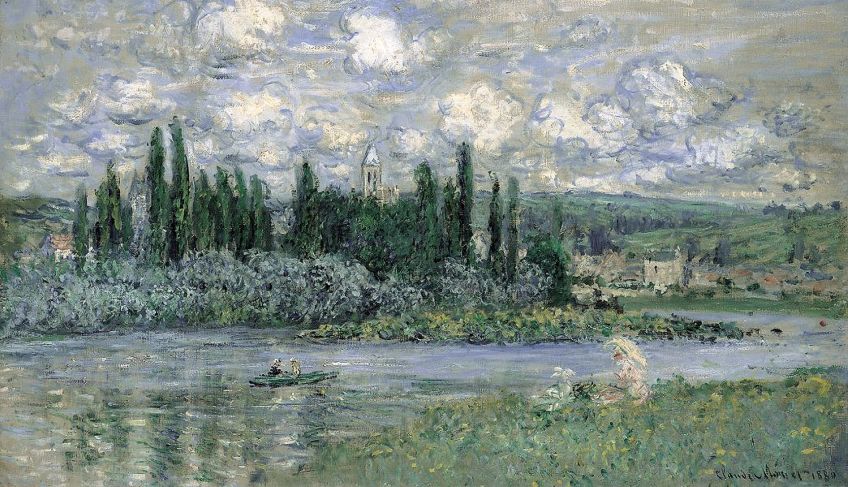
A significant change that occurred during the Impressionist era was that painting began to take place en-plein-air or outside. Much of the Impressionists’ ability to capture the complex and ever-changing colors of the natural world were a result of this shift. Impressionist artists also began to move away from the desire to lecture and teach, preferring to create art for art’s sake. Galleries and international exhibitions became increasingly important to the spread of such philosophies in art and painting.
Symbolism (1886 – 1900): There is Always More Than Meets the Eye
Between 1886 and 1900, the era of Symbolism began to emerge in France as a literary movement that soon influenced the world of visual art. Artists became preoccupied with the representation of feelings and thoughts through objects. The common themes of the Symbolism movement included death, sickness, sin, and passion. The forms were mostly clear, a fact which art historians believe was in anticipation of the Art Nouveau era.
Post-Impressionism (1886 – 1905): Expression Over Naturalism
The post-Impressionist period followed the era of Impressionism and was defined by its rejection of Naturalism as it applied to the representation of color and expression. The art movement was also coined by the 20th century art critic Roger Fry in 1910 and was a term used to describe the development of art after the styles proposed by Édouard Manet. Post-Impressionism embraced the idea of deep symbolism rather than the mere representation of optical impressions drawn from nature.
Famous artists who followed the stylistic conventions of post-Impressionism include Paul Gauguin, Georges Seurat, Vincent van Gogh, and the iconic Paul Cézanne.
Although these artists operated independently, their works possess similarities that differ from the norms of Impressionism and offer a more emotionally charged atmosphere. While artists like Georges Seurat created his own unique style of painting, traditional mediums saw the use of innovative techniques that made each of these artists stand out from the rest of the art crowd of the early 20th century. Famous Fauvists such as Henri Matisse was also greatly influenced by the work of renowned post-Impressionists such as Paul Signac and John Russell.
Art Nouveau (1890 – 1910): All That Glitters is Klimt
Although Gustav Klimt was by no means the most important artist in the Art Nouveau movement, he is one of the most well-known. His style perfectly encapsulates the Art Nouveau movement with soft, curved lines, lots of florals, and the stylistic characterization of human figures. In many countries, this style is known as the Secession style.
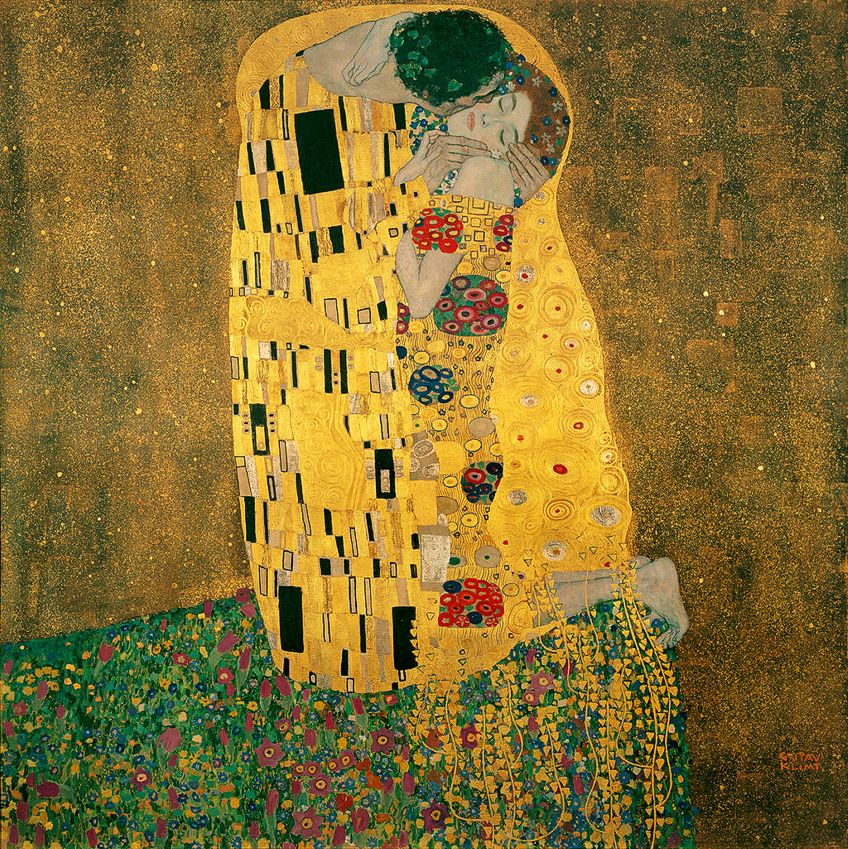
The art produced in the Art Nouveau period includes a lot of symmetry and is characterized by playfulness and youthfulness. Art Nouveau has a lot of political content, although many critics ignore this and hold the decorative aspects against it. Through the art of the Art Nouveau period, artists attempted to bring nature back into industrial cities.
Expressionism (1890 – 1914): Bringing a Political Edge to the Debate
In the Expressionism art era, we once again see a resurgence of the importance of the expression of subjective feelings. Expressionism originated in Germany and reflected many artists’ criticism of power. The artists within this movement were not interested in Naturalism or what things look like on the outside. As a result, there was a tinge of aggression in some Expressionist paintings, which are often archaic and expressive. Wassily Kandinsky was one such Modern artist who leveraged Expressionism styles in his abstract compositions to explore color theory, form, and pure abstraction in painting.
Towards the beginning of the First World War, Expressionist paintings had a disturbing intensity about them. Expressionism was one such movement that reflected direct political messages through painting and a sort of violence in brushwork styles.
Cubism (1906 – 1914): Distorting Representation
Beginning with two artists, Pablo Picasso and Georges Braque, the Cubist movement was all about fragmentation, geometric shapes, and multiple perspectives. The dimensional planes of everyday objects were broken down into different geometric segments and put back together in a way that presented the object from multiple sides simultaneously. Cubism was a rejection of all the rules of traditional Western painting and has had a strong influence on the styles of art that have followed it.

Futurism (1909 – 1945): Artistic Anarchism
Futurism is less of an artistic style and more of an artistically inspired political movement. Founded by Tommaso Marinetti’s Futurist Manifesto, which rejected social organization and Christian morality, the Futurist era was full of chaos, hostility, aggression, and anger. Although Marinetti was not a painter himself, painting became the most prominent form of art within the Futurist movement.
These artists vehemently rejected the rules of Classical painting, believing that everything that was passed through generations (beliefs, traditions, religion) was suspicious and dangerous. The militant nature of the Futurist movement resulted in many people believing that it was too closely affiliated with Fascism.
Dadaism (1912 – 1920): Life is Nonsense
Dada means a great many things and nothing at all. The writer Hugo Ball discovered that this small word has several different meanings in different languages and at the same time, as a word, it meant nothing at all. The Dadaism movement is based on the concepts of illogic and provocation and was seen as not only an art movement, but an anti-war movement.
The illogic of existing rules, norms, traditions, and values was called into question by the Dadaist movement. The art movement encompassed several art forms including writing, poetry, dance, and performance art. Part of the movement was to call into question what could be classified as “art”. Artists such as Henri-Robert-Marcel Duchamp also leveraged Dadaism and Surrealism to define the foundations of conceptual art, which paved the path forward for later Modern art movements.
Dadaism represents the beginnings of action art in which painting becomes more than just a portrait of reality, but rather an amalgamation of the social, cultural, and subjective parts of being human.
Constructivism (1913 – 1930): The Union of Cubism and Futurism
In 1913, the Russian Konstruktivizm movement emerged with the abstract paintings of Vladimir Tatlin, which went on to influence the development of abstract modern art itself. The art period is also recognized as a historical movement that involved the arrangement of geometric forms in a harmonious manner. Painters who explored Constructivism rejected bright colors and expanded the styles found in earlier movements such as Suprematism.
The conceptual theory behind the era was shaped by Jean Piaget, whose work in educational psychology and cognitive development expanded on how humans create meaning and explored the relationships between human experiences and their ideas. The theory also described the idea that human create their own knowledge.
Bold typography and constructed photomontages became the essence of Konstruktivizm with minimal color palettes. The era proved to be incredibly influential in the fields of design and architecture, which shifted from political connotations to a dynamic design style throughout the 1920s. Famous Russian artist Kazimir Malevich also coined the term “Constructivist” while referring to the work of Alexander Rodchenko, a well-known Russian designer.
The Harlem Renaissance (1920 – 1930): The Revival of African-American Culture
The Harlem Renaissance was a decade of significant cultural rebirth for the African-American communities of America in the 1920s. The period was characterized by the recognition and production of intellectual and cultural art forms spanning music, literature, visual art, poetry, politics, dance, and fashion produced by African-American individuals.
The period is also recognized as the New Negro Movement and encompassed a variety of unique Contemporary art styles that focused on relaying the Black experience from a non-Western perspective in light of the historical negation of African-American scholars and artists.
The Harlem Renaissance originated in the New York neighborhood of Harlem, which debuted many cultural icons that promoted African-American culture and the recognition of Black artists in the early 20th century. The period fostered a strong commitment to political activism, which went on to influence important movements such as the Civil Rights Movement of the 1950s.
Surrealism (1920 – 1930): Subconscious Realities
As if the pure illogic nature of the Dadaism movement was not outlandish enough, the Surrealists took the dream world to be the fountain of all truth. One of the most famous Surrealist artists is Salvador Dalí, and you are bound to know his painting Melting Watch (1954).
Surrealism was fundamentally psychoanalytical and many Surrealist artists would paint directly from their dreams.
Sometimes dealing with uncomfortable concepts, hidden desires, and taboos, Surrealism was a direct critique of the ingrained ideas and beliefs of the bourgeoise. As you can imagine, this style of art was not popular when it began, but it has greatly influenced the world of modern art.

New Objectivity (1925 – 1965): Cold and Technical
The different art periods from the 1960s to the Contemporary era mark the height of Modern art and the development of art styles that proved significantly influential in redefining notions of representation, visual aesthetics, and postwar culture.
The New Objectivity movement of the 1960s turned towards themes that dealt with social and political critique. The turbulence of the war left many people searching for some kind of order to hold onto, and this can be seen clearly in the art of New Objectivity.
The images represented in New Objectivity were often cold, unemotional, and technical, with some common subjects such as the radio and lightbulbs. As is the case with many Modern movements in art, there were several different wings to the New Objectivity movement.
Abstract Expressionism (1948 – 1962): Stepping Away from Europe
The 1960s also produced one of the most impactful art periods shaped by Abstract Expressionism. The art world saw many post-World War II painters from the United States embrace abstract approaches to painting as a means of expressing emotion. Abstract Expressionism is said to be the first art movement to originate outside of Europe. Emerging from North America, Abstract Expressionism focused on color-field painting and action paintings. Rather than using a canvas and a brush, buckets of paint would be poured on the ground, and artists used their fingers to create images.
With well-known artists of the 1960s include figures like Marc Tobey and Jackson Pollock, who piloted the style of the art movement. The application of the paint in Abstract Expressionism was sometimes so thick that the finished piece would take on a form unlike any painting before it. As with all art, there are always critics, with conservative Americans during the cold war calling it “un-American.”
Pop Art (1955 – 1969): Art is Everything
For the artists of Pop art period, almost every aspect of popular culture in the world was art. From advertisements, tin cans, toothpaste, and toilets, everything was art. Pop art developed simultaneously in the United States and England and was characterized by uniform blocks of color and clear lines and contours. Painting and graphic art became influenced by Photorealism and serial prints.
One of the most famous English Pop artists was David Hockney, although only a few of his lifetime paintings were in this movement. Another iconic legend of the Pop art era in the 1960s was Andy Warhol, whose most popular artworks were inspired by vivid imagery from popular culture and Hollywood’s finest celebrities, including Marilyn Monroe and Elizabeth Taylor.
Neo-Expressionism (1980 – 1989): Modern Fauvism
Starting in the 1980s, Neo-Expressionism emerged with large-format representational and life-affirming paintings. Berlin was a central point for this new movement, and the designs typically featured cities and big-city life. The name Neo-Expressionism emerged from Fauvism, and although the artists in Berlin disbanded in 1989, some artists continued to paint in this style in New York.
Art is a fundamental part of what it means to be human. Many of the troubles and joys we experience can only be captured accurately through artistic expression. We hope that this short summary of the art periods timeline has helped you gain more insight into the contexts surrounding some of the most famous works of art.
We’ve also created a web story about art periods.
Frequently Asked Questions
What Is an Art Period?
In art history, an art period is understood as a particular span of time that encompasses various artists and their artworks, whose works are classified under a particular style or movement within art. Art periods indicate eras of significant change or evolution in the trajectory of art and the way it is understood by society. Art periods usually highlight a focused goal and may encompass multiple art movements.
What Is the Difference Between an Art Period and an Art Movement?
Art movements differ from art periods since art periods are categorized and understood according to time and the different eras they encompass, while art movements are formed by artists in a conscious manner and share a common philosophy. Art periods are used to classify artists according to the style of the time and is a broader category that can encompass more than one art movement.
What Is the Current Art Period Called?
The art period of the present is known as the Contemporary art period, which encompasses art and new styles of art produced from the late-1970s until the current era. The Contemporary art period is characterized by art formed within the context of a globalized and technologically advanced era.
Why Was the Renaissance Art Period Important?
The Renaissance art period is a broad art era that is considered significant for the many cultural changes that occurred in multiple disciplines in Europe. The era was recognized as a widespread period of cultural rebirth that saw the revival of Classical subjects across philosophy, literature, visual art, and science. The Renaissance also included the Northern Renaissance, which occurred from the late-15th century and spread to the North of the Alps. The Northern Renaissance was considered particularly important since it birthed many advanced oil painting techniques and approaches in printmaking.
Isabella studied at the University of Cape Town in South Africa and graduated with a Bachelor of Arts majoring in English Literature & Language and Psychology. Throughout her undergraduate years, she took Art History as an additional subject and absolutely loved it. Building on from her art history knowledge that began in high school, art has always been a particular area of fascination for her. From learning about artworks previously unknown to her, or sharpening her existing understanding of specific works, the ability to continue learning within this interesting sphere excites her greatly.
Her focal points of interest in art history encompass profiling specific artists and art movements, as it is these areas where she is able to really dig deep into the rich narrative of the art world. Additionally, she particularly enjoys exploring the different artistic styles of the 20th century, as well as the important impact that female artists have had on the development of art history.
Learn more about Isabella Meyer and the Art in Context Team.
Cite this Article
Isabella, Meyer, “Art Periods – A Detailed Look at the Art History Timeline.” Art in Context. December 17, 2020. URL: https://artincontext.org/art-periods/
Meyer, I. (2020, 17 December). Art Periods – A Detailed Look at the Art History Timeline. Art in Context. https://artincontext.org/art-periods/
Meyer, Isabella. “Art Periods – A Detailed Look at the Art History Timeline.” Art in Context, December 17, 2020. https://artincontext.org/art-periods/.


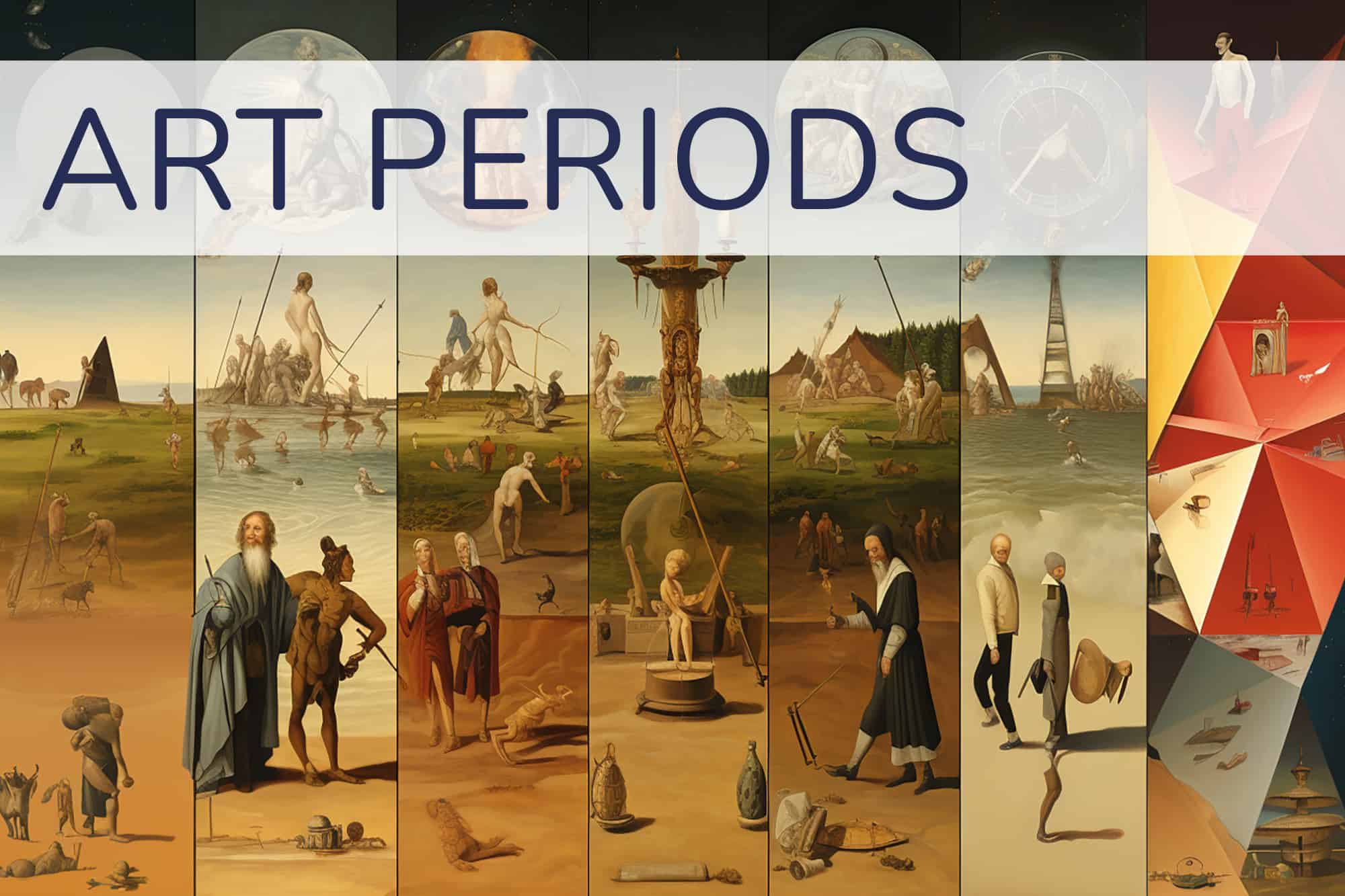

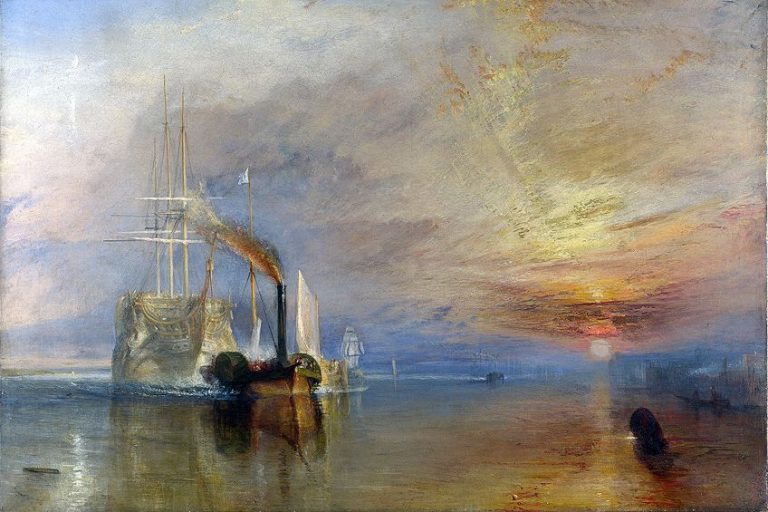
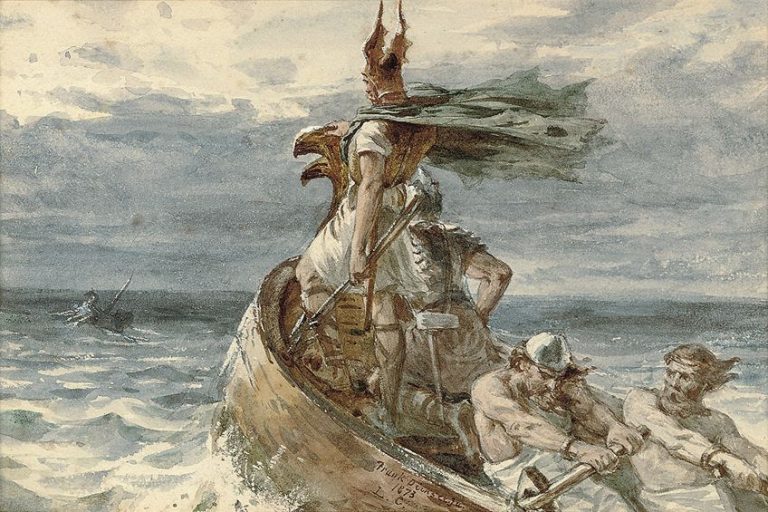
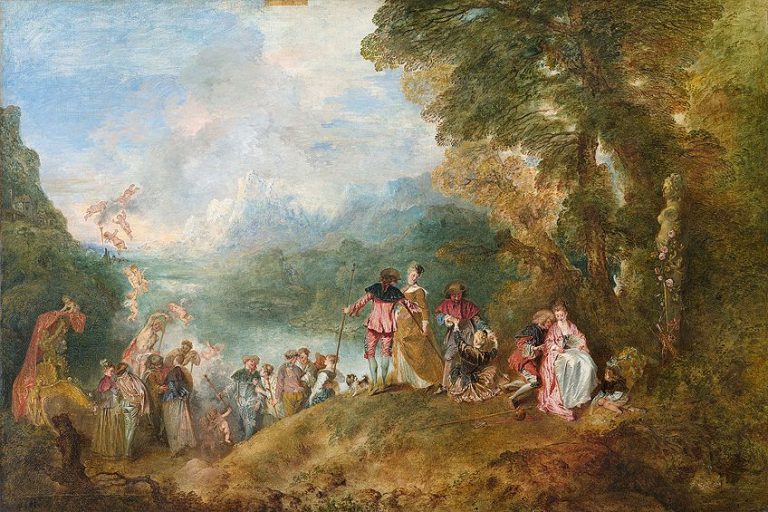
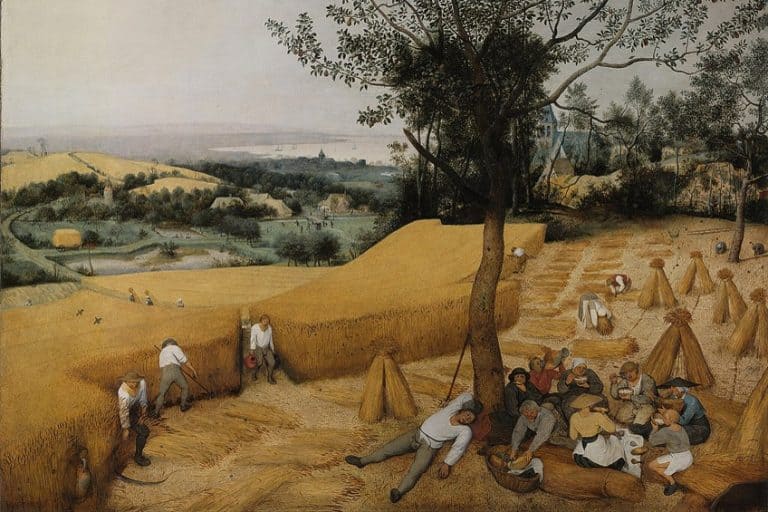
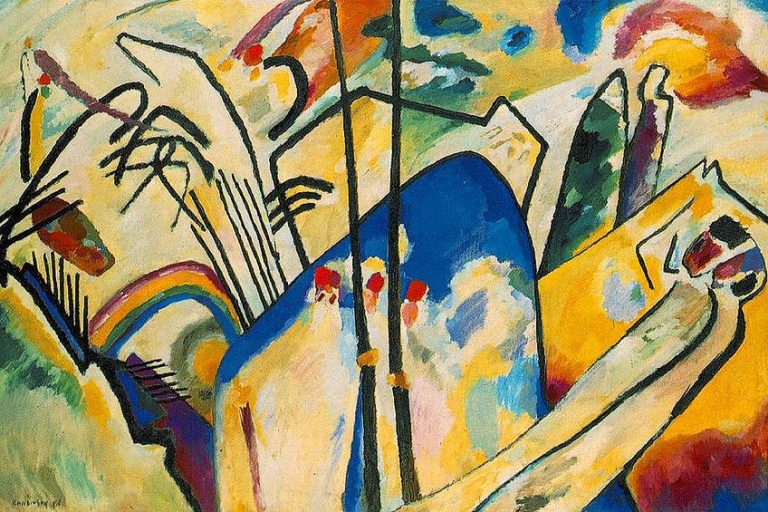

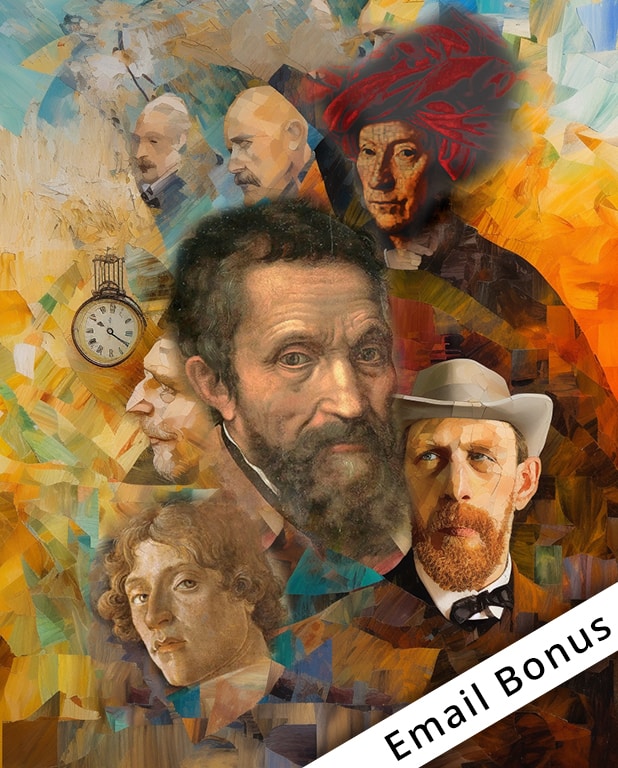

All is lovely, “is OK”, but only till Surrealism (and few of this, I want believe that I understand). Am I so old ? Am I one of them can not addapted ?